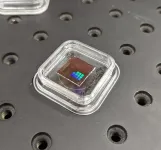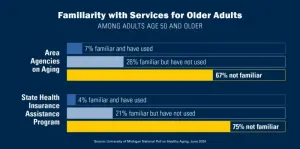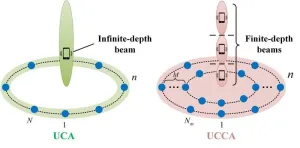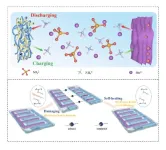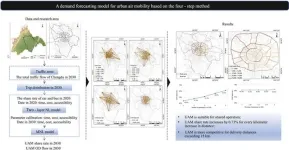(Press-News.org) Restricting use in bedrooms and at mealtimes have the biggest impact, but modeling good behavior is also important.
For many parents, it can feel like curbing kids’ screen use is a losing battle. But new research from UC San Francisco (UCSF) has found the parenting practices that work best to curb screen time and addictive screen behavior: restricting screens in bedrooms and at mealtimes and modeling healthy practices at home.
Researchers asked 12- to 13-year-olds how often they used screens for everything but school, including gaming, texting, social media, video chatting, watching videos and browsing the internet; and whether their screen use was problematic.
Then, they asked parents how they used their own screens in front of their kids, how they monitored and restricted their kids’ screen use, and whether they used it to reward or punish behavior. They also asked about the family’s use of screens at mealtimes and the child’s use of screens in the bedroom.
Using screens in bedrooms and at mealtime were linked to increased time and addictive use. But use went down when parents kept track of and limited their kids’ screen time, and when they modeled healthy behavior themselves.
“These results are heartening because they give parents some concrete strategies they can use with their tweens and young teens: set screen time limits, keep track of your kids’ screen use, and avoid screens in bedrooms and at mealtimes,” said Jason Nagata, MD, a pediatrician at UCSF Benioff Children’s Hospitals and the first author of the study, publishing June 5 in Pediatric Research. “Also, try to practice what you preach.”
Refining AAP guidance
The study analyzed the effectiveness on tweens of parenting strategies recommended by the American Academy of Pediatrics’ (AAP) for children and adolescents aged 5 to 18 years old. It is one of the few studies to examine how parenting practices affect screen use in early adolescence, when children start to become more independent.
“We wanted to look at young adolescents in particular, because they are at a stage when mobile phone and social media use often ramps up and sets the course for future habits,” Nagata said.
The researchers collected data from 10,048 U.S. participants, 46% of whom were racial or ethnic minorities, from the Adolescent Brain Cognitive Development (ABCD) study.
Parents were asked to rate, on a scale of 1 to 4, their level of agreement with such statements as, “My child falls asleep using a screen-based device.”
The researchers then looked to see how the level of parental agreement predicted the children’s daily screen time, and found it went up 1.6 hours for each additional point related to bedroom screen use. The same held true for using screens at mealtimes, which added 1.24 hours. Poor modeling by parents added 0.66 hours.
Limiting and monitoring their kids’ screen time reduced it by 1.29 hours and 0.83 hours, respectively. But using screen time as either a reward or a punishment was not effective, resulting in 0.36 more hours, as well as more problematic video game use.
Used in moderation, screens can help maintain social connections and foster community, but especially for children, problematic use can lead to mental health problems, as well as physical inactivity and problems with sleep.
"Screen time at bedtime displaces sleep time, which is essential for health and development in young adolescents,” Nagata said. “Parents can consider keeping screens outside their children’s bedroom and turning off devices and notifications overnight.”
Authors: Additional UCSF co-authors are Angel Paul, Felicia Yen, Zacariah Smith-Russack, Iris Yuefan Shao, PhD and Abubakr A.A. Al-shoaibi, PhD.
Funding: The work was supported by grants from the National Institutes of Health (K08HL159350 and R01MH135492) and the Doris Duke Charitable Foundation (2022056). The ABCD Study was supported by the National Institutes of Health and additional federal partners under award numbers U01DA041022, U01DA041025, U01DA041028, U01DA041048, U01DA041089, U01DA041093, U01DA041106, U01DA041117, U01DA041120, U01DA041134, U01DA041148, U01DA041156, U01DA041174, U24DA041123, and U24DA041147.
About UCSF Health: UCSF Health is recognized worldwide for its innovative patient care, reflecting the latest medical knowledge, advanced technologies and pioneering research. It includes the flagship UCSF Medical Center, which is a top-ranked hospital, as well as UCSF Benioff Children’s Hospitals, with campuses in San Francisco and Oakland; Langley Porter Psychiatric Hospital; UCSF Benioff Children’s Physicians; and the UCSF Faculty Practice. These hospitals serve as the academic medical center of the University of California, San Francisco, which is world-renowned for its graduate-level health sciences education and biomedical research. UCSF Health has affiliations with hospitals and health organizations throughout the Bay Area. Visit https://www.ucsfhealth.org/. Follow UCSF Health on Facebook or on Twitter
###
Follow UCSF
ucsf.edu | Facebook.com/ucsf | Twitter.com/ucsf | YouTube.com/ucsf
END
Great news, parents: You do have power over your tweens’ screen use
2024-06-05
ELSE PRESS RELEASES FROM THIS DATE:
Breakthrough in battery technology: iron-chromium redox flow batteries enhanced with N-B doped electrodes
2024-06-05
Researchers at the State Key Laboratory of Heavy Oil Processing, China University of Petroleum Beijing, have achieved a significant advancement in battery technology that could revolutionize how energy is stored and utilized, particularly for large-scale applications. In a recently published article in the journal Green Energy and Intelligent Transportation, the team, led by Yingchun Niu and Senwei Zeng, introduced a novel N-B doped composite electrode for iron-chromium redox flow batteries (ICRFB), demonstrating outstanding improvements in performance and efficiency.
Iron-chromium redox flow batteries are pivotal in addressing the ...
AI approach elevates plasma performance and stability across fusion devices
2024-06-05
Achieving a sustained fusion reaction is a delicate balancing act, requiring a sea of moving parts to come together to maintain a high-performing plasma: one that is dense enough, hot enough, and confined for long enough for fusion to take place.
Yet as researchers push the limits of plasma performance, they have encountered new challenges for keeping plasmas under control, including one that involves bursts of energy escaping from the edge of a super-hot plasma. These edge bursts negatively impact overall performance and even damage the plasma-facing ...
Tiny crop-health sensors could help cut the cost of groceries
2024-06-05
A compact, lightweight sensor system with infrared imaging capabilities developed by an international team of engineers could be easily fitted to a drone for remote crop monitoring.
This flat-optics technology has the potential to replace traditional optical lens applications for environmental sensing in a range of industries.
This innovation could result in cheaper groceries as farmers would be able to pinpoint which crops require irrigation, fertilisation and pest control, instead of taking a one-size-fits-all approach, thereby potentially boosting their harvests.
The sensor system can rapidly switch between edge ...
Uptake of tire wear additives by vegetables grown for human consumption
2024-06-05
Car tires contain hundreds of chemical additives that can leach out of them. This is how they end up in crops and subsequently in the food chain. Researchers at the Center for Microbiology and Environmental Systems Science at the University of Vienna and the Hebrew University of Jerusalem have now detected these chemical residues in leafy vegetables for the first time. Although the concentrations were low, the evidence was clear, a finding that is also known for drug residues in plant-based foods. The study was published in the internationally renowned journal Frontiers in Environmental Science.
The presence of drug residues in commercially sold fruit ...
Most older adults don’t know about resources that can help them navigate aging & caregiving
2024-06-05
Older Americans may be missing out on a wide range of programs and services that could help them meet their needs or assist their aging loved ones, a new poll suggests.
The new findings from the National Poll on Healthy Aging, based at the University of Michigan, show most older adults don’t know about important public resources for older adults and their caregivers, either by name or general description.
The poll asked more than 4,000 adults over age 50 about their awareness and use of Area Agencies on Aging (AAAs), State Health Insurance Assistance ...
Bone loss drugs can help azoles fight fungal infections
2024-06-05
Highlights:
Dermatophytes are fungi that cause skin, hair and nail fungal infections.
These infections often develop resistance to azoles, a common anti-fungal treatment.
A new study suggests that adding common bone loss drugs to azoles can improve efficacy.
In lab tests, combinations of these drugs worked against dermatophyte species and prevented resistance.
Washington, D.C.—Human skin, hair and nails are all vulnerable to fungal infections. While these infections are usually not serious, they’re difficult to fully resolve and often recur after treatment—sometimes for years. They’re also often resistant to treatments, including a common class of antifungals ...
Focusing ability enhancement in broadside direction of array: from UCA to UCCA
2024-06-05
Benefits of emerging near-field communications:
The progression of 5G mobile communication commercialization has spurred anticipation for 6G communication. To support emerging applications like digital twins, holographic video, and augmented reality (AR), extremely large-scale antenna array (ELAA) is regarded as key candidates for future 6G mobile communication due to its potential to enhance spectrum efficiency.
“Compared with 5G massive multiple-input multiple-output (MIMO) systems, 6G ELAA not only entails an increase in the number of antennas, but also signifies a fundamental shift in electromagnetic ...
Safer, cheaper, more flexible battery invented for wearable tech
2024-06-05
Researchers have developed a safer, cheaper, better performing and more flexible battery option for wearable devices.
A paper describing the ‘recipe’ for their new battery type was published in the journal Nano Research Energy on June 3.
Fitness trackers. Smart watches. Virtual-reality headsets. Even smart clothing and implants. Wearable smart devices are everywhere these days. But for greater comfort, reliability and longevity, these devices will require greater levels of flexibility and miniaturization of their energy storage mechanisms, which are often frustratingly bulky, heavy and fragile. On top of this, any improvements cannot come at the expense of ...
Case Western Reserve University researchers develop new method of DNA testing—expanding scientific innovation
2024-06-05
CLEVELAND—A team of researchers from the Case Western Reserve University School of Medicine has developed a new method for target DNA sequence amplification, testing and analysis.
This new technique, or reaction, known as AMPLON (Amplifying DNA with Multiarm Priming and Looping Optimization of Nucleic Acid), offers an alternative to the previously accepted “gold-standard” Polymerase Chain Reaction (PCR) method, opening the opportunity for more applications in medical diagnosis.
The team’s findings were recently published in the journal Advanced Materials.
“AMPLON ...
Advancing Urban Mobility: Chengdu's 2030 UAM Forecast
2024-06-05
Chengdu, a bustling city, is on the brink of revolutionizing its transportation landscape by introducing Urban Air Mobility (UAM). A recent study named “A demand forecasting model for urban air mobility in Chengdu, China” conducted by a team of researchers from the Institute of Geographic Sciences and Natural Resources Research, Chinese Academy of Sciences, proposes a sophisticated model to predict the future demand for UAM in Chengdu by 2030.
Urban Air Mobility refers to the use of Electric Vertical Take-Off and Landing (eVTOL) aircraft to transport people and goods across urban areas, potentially easing the notorious ...


